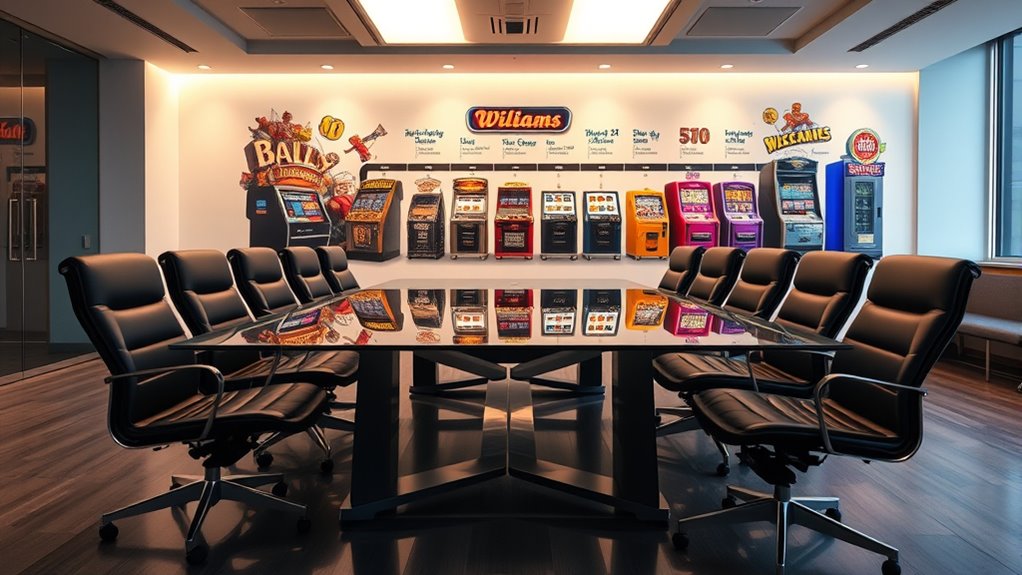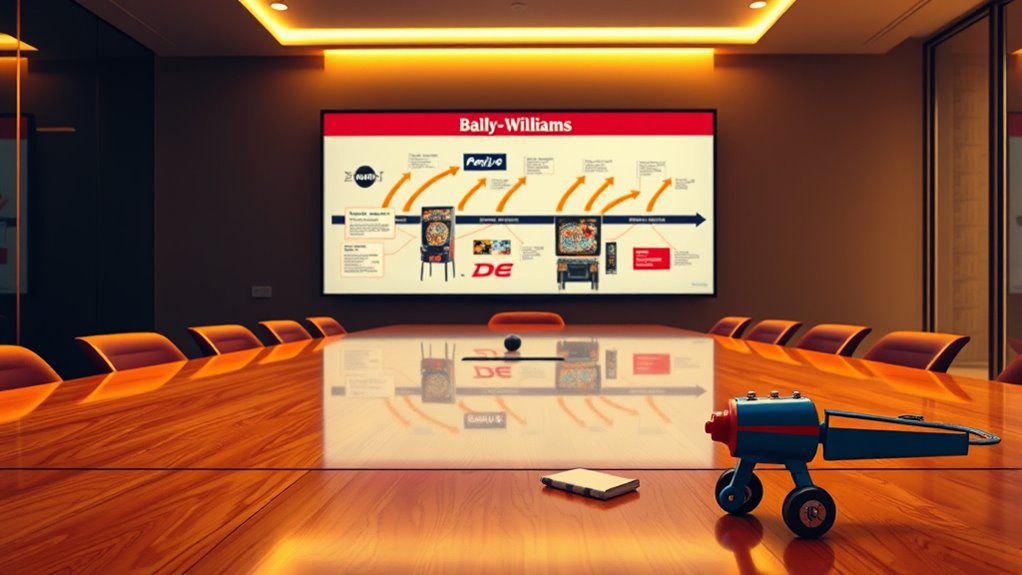The Bally–Williams merger combined two gaming legends, uniting their innovative brands to reshape the industry. Bally’s roots in pinball and slots merged with Williams’ success in pinball and video games, driving growth and technological progress. The move aimed to strengthen market positions, boost innovation, and expand reach across entertainment sectors. While industry reactions were mixed, the merger set the stage for game-changing advances and industry leadership. Discover how this partnership’s challenges and innovations continue to influence gaming today.
Key Takeaways
- Bally and Williams merged to strengthen industry leadership, combining their innovative legacies in pinball, arcade, and gaming sectors.
- The merger aimed to accelerate technological innovation and expand market reach across entertainment segments.
- Industry reaction was mixed, with excitement for growth opportunities but concerns over integration challenges.
- Cultural integration and employee retention were critical to the merger’s success, fostering creativity and strategic collaboration.
- Post-merger, the companies led advancements like robotics and virtual reality, solidifying their influence in gaming technology.
The Roots of Bally and Williams: Industry Leaders in Gaming

Bally and Williams quickly established themselves as industry leaders in gaming by innovating and expanding their product lines. They focused on market diversification, branching into new gaming segments to reach broader audiences. Bally’s early success came from creating popular pinball machines and slot machines, broadening its portfolio beyond traditional casino games. Williams, on the other hand, gained recognition through innovative pinball designs and later embraced video gaming. Both companies understood the importance of brand synergy, leveraging their strong reputations to strengthen their market positions. Their strategic growth allowed them to diversify their offerings, reduce reliance on single product lines, and capitalize on emerging trends. This foundation of innovation and collaboration set the stage for their eventual merger, uniting their strengths under a shared vision of industry leadership. Additionally, their ability to adapt to changing technology trends helped cement their roles as pioneers in the gaming industry.
The Strategic Move: Motivations Behind the Merger

The merger between Bally and Williams was driven by a shared desire to strengthen their market positions and stay ahead in a rapidly evolving industry. You recognize that combining resources enables both companies to pursue aggressive market expansion, reaching new demographics and geographic areas. This strategic move enhances their competitive positioning, allowing them to innovate faster and respond more effectively to industry shifts. To illustrate, consider the following:
| Motivation | Outcome |
|---|---|
| Market expansion | Access to wider customer bases |
| Competitive positioning | Strengthened industry presence |
| Industry evolution | Ability to adapt quickly and innovate |
This alignment of goals guarantees they can capitalize on emerging opportunities while solidifying their leadership in the gaming industry. Moreover, understanding the importance of technological advancements helps explain how the companies plan to stay competitive in the future.
The Merger Announcement and Industry Reaction

When news of the Bally-Williams merger broke, industry insiders and market analysts quickly responded with a mix of excitement and skepticism. The announcement signaled a major move in market consolidation, capturing attention across the gaming and entertainment sectors. Many saw it as a strategic effort to strengthen competitive positioning and expand market share. Shareholders generally welcomed the news, expecting enhanced shareholder value through increased scale and resource integration. However, some skeptics questioned whether the merger would deliver the promised synergies or lead to reduced competition. The industry reaction was immediate, with stock prices fluctuating and analysts closely monitoring the potential impact. Additionally, the integration process might influence entertainment and parks support hours and operations, which could affect consumer experiences. Overall, the merger sparked intense debate about its long-term implications for market dynamics and shareholder interests.
Integration Challenges and Opportunities

What are the biggest hurdles and opportunities as Bally and Williams work to integrate their operations? Cultural integration poses a key challenge; aligning two distinct corporate cultures requires effort and clear communication. If done well, it creates a unified identity that boosts morale and collaboration. Employee retention is another critical focus. You need to reassure staff that their roles are secure and valued, which helps prevent turnover during the *shift*. On the upside, the merger offers a chance to combine best practices, streamline processes, and foster innovation. By actively managing cultural differences and engaging employees, you can turn these challenges into opportunities for growth. Successfully integrating corporate cultures will set the foundation for future success and industry leadership.
Innovations and Industry Impact Post-Merger

After the merger, you’ll see how Bally and Williams pushed technological boundaries to create innovative gaming experiences. Their combined efforts set new industry standards and influenced emerging trends. This period marked a significant shift in industry leadership and technological progress. Notably, their focus on industry innovation helped shape the future landscape of gaming technology.
Technological Advancements Achieved
The Bally–Williams merger propelled a wave of technological innovations that transformed the arcade and pinball industries. You saw the rise of cutting-edge robotics, which enhanced game mechanics and introduced more interactive, lifelike gameplay experiences. These advancements pushed the boundaries of traditional pinball, making machines smarter and more engaging. Additionally, virtual reality technologies began to emerge, offering immersive experiences that captivated players and expanded the industry’s reach. These innovations not only improved game design but also set new standards for industry competitiveness. By integrating robotics and virtual reality, Bally–Williams helped redefine entertainment technology, ensuring their influence remains evident in today’s gaming landscape. Your understanding of this technological progression highlights how the merger catalyzed industry evolution and innovation. Moreover, the emphasis on emotional support and user engagement helped sustain consumer interest and foster loyalty in a competitive market.
Industry Leadership and Trends
Following the technological innovations spurred by the Bally–Williams merger, the companies established themselves as industry leaders by setting new standards for design, quality, and innovation. This move accelerated market consolidation, reducing competition and enabling them to shape industry trends. Their strong corporate branding reinforced their reputation, attracting new customers and retaining loyal ones. As leaders, they pushed boundaries with groundbreaking pinball designs and cutting-edge technologies, influencing the entire industry. Their strategic focus on innovation and branding allowed them to maintain dominance, inspiring competitors to follow suit. The merger not only transformed their operations but also set a new benchmark for excellence in gaming entertainment, securing their position at the forefront of the industry for years to come. Notably, their commitment to industry leadership has driven continuous advancements that benefit both consumers and the industry as a whole.
Legacy and Lessons From the Bally–Williams Alliance

Your experience shows how merging industry legacies can create a lasting impact and inspire future innovations. By working together, Bally and Williams demonstrated the power of collaboration to push boundaries. The lessons learned from their strategy highlight what businesses can do to succeed through thoughtful partnerships. Integrating innovative technology from both companies allowed them to develop more advanced and efficient products, setting a new standard in their industry.
Merging Industry Legacies
When Bally and Williams merged, they combined two powerful legacies that had shaped the arcade and pinball industries for decades. This union allowed both brands to evolve their identities and reach broader markets. You can see how their combined efforts fostered brand evolution, strengthening recognition across diverse entertainment sectors. Consider these key lessons: 1. Leverage legacy to build trust and expand market presence. 2. Use brand evolution to stay relevant amid industry shifts. 3. Focus on integrating strengths for extensive market expansion. 4. Recognize that merging industry legacies creates opportunities for innovation and growth. Additionally, understanding the importance of brand recognition can help companies maintain their competitive edge during such mergers.
Innovation Through Collaboration
The Bally–Williams alliance exemplifies how collaboration can spark innovation by combining complementary strengths and shared expertise. By fostering cross-cultural synergy, both companies brought unique perspectives and approaches to problem-solving, leading to creative breakthroughs. Their joint efforts demonstrated that leveraging diverse innovation strategies fuels continuous improvement and competitive advantage. The partnership encouraged open exchange of ideas, blending Bally’s craftsmanship with Williams’ technological prowess. This collaborative environment not only accelerated product development but also inspired new ways of thinking about entertainment and manufacturing. The alliance’s success highlights that embracing different viewpoints and working closely across cultural boundaries can produce innovative solutions that neither company could achieve alone. Ultimately, their shared commitment to innovation strategies through collaboration set a lasting example for industry progress.
Lessons in Business Strategy
The Bally–Williams alliance offers valuable lessons in business strategy that extend beyond its immediate innovations. It shows how leveraging brand synergy can strengthen market positions and fuel growth. To succeed, focus on:
- Building strong brand synergy to create a unified identity that appeals across markets.
- Using strategic collaborations to accelerate market expansion and reach new customer segments.
- Balancing innovation with core strengths to maintain competitive advantage.
- Fostering agility, so your business adapts quickly to changing industry dynamics.
Frequently Asked Questions
How Did the Merger Influence the Global Gaming Industry?
The merger considerably impacted the global gaming industry by shaping merger dynamics and accelerating industry transformation. You see, it combined Bally’s innovative approach with Williams’ technological expertise, creating a powerhouse that set new standards. This move encouraged other companies to pursue strategic alliances, fostering innovation and competition worldwide. As a result, the industry evolved faster, embracing new technologies and expanding into digital markets, ultimately transforming how players engage with gaming entertainment.
What Were the Biggest Regulatory Hurdles Faced During the Merger Process?
You might find it surprising that securing antitrust approval took over a year, highlighting the complex regulatory compliance involved. During the merger, you face significant hurdles, such as maneuvering antitrust approval processes that scrutinize market dominance. You need to demonstrate that the deal won’t harm competition, which can delay or block the merger. Regulatory agencies carefully review financial impacts, ensuring your move aligns with fair market practices and prevents monopolistic behavior.
How Did Employees From Both Companies Adapt to the Merger?
You might notice that employees from both companies had to focus on employee integration and cultural adaptation to make the merger successful. They worked to build trust, share best practices, and align their values. Through open communication and teamwork, they navigated differences and fostered a unified company culture. This effort helped smooth transitions, boost morale, and guarantee that everyone moved forward together during the challenging period of change.
What Was the Financial Impact of the Merger on Both Companies?
You see that the merger’s financial consequences included improved stock performance for both companies, reflecting increased investor confidence. The combined entity experienced higher revenues and expanded market share, boosting overall profitability. However, there were also initial integration costs that temporarily affected earnings. Overall, the merger positively impacted both companies’ financial health, strengthening their competitive position and leading to long-term growth as reflected in their stock performance.
How Did the Merger Influence Innovation in Arcade and Pinball Technology?
You see, the merger sparked significant technological innovation, driven by the synergy between the companies. This collaboration pushed the boundaries of arcade and pinball technology, leading to more sophisticated and engaging games. The combined expertise allowed for faster development cycles and groundbreaking features. As a result, players experienced a surge of exciting, innovative machines, transforming the arcade scene and setting new standards for game design and entertainment.
Conclusion
When you look at the Bally–Williams merger, it’s like watching two giants dance in perfect harmony, shaping the future of gaming. This alliance didn’t just blend strengths; it sparked innovation and set new industry standards. Though challenges arose, their story shows how bold moves can turn obstacles into opportunities. As you reflect, remember—this merger’s legacy is a shining beacon guiding the industry’s ongoing evolution, proving that even giants can grow stronger together.









